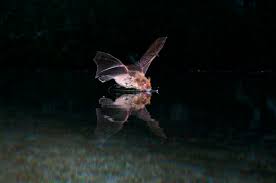Echolocating Bats Navigate Using Acoustic Cognitive Maps

A recent study published in *Science* reveals that echolocating bats have developed an acoustic cognitive map of their home range, allowing them to navigate over kilometer-scale distances using echolocation alone. Researchers from the Max Planck Institute of Animal Behavior, the University of Konstanz, Tel Aviv University, and the Hebrew University of Jerusalem conducted this groundbreaking study.
Imagine trying to recognize your location and find your way home from any random point within a three-kilometer radius in complete darkness, relying only on a flashlight. Echolocating bats face a similar challenge, using sound waves instead of light. While bats have long been recognized for their echolocation abilities to avoid obstacles, this research led by Aya Goldshtein demonstrates that they can also identify their location after being displaced and navigate using an internal map.
The study focused on Kuhl's pipistrelle (Pipistrellus kuhlii), a bat species weighing just 6 grams, in Israel's Hula Valley. Over several nights, the researchers tracked 76 bats near their roosts and relocated them within a three-kilometer radius. The bats were equipped with an innovative lightweight reverse GPS tracking system called ATLAS, which allowed for high-resolution tracking. While some bats were solely fitted with the ATLAS system, others underwent additional manipulations to assess how various senses influenced their navigation.
Remarkably, 95 percent of the bats were able to return to their roosts within minutes, relying solely on echolocation. This finding underscores the efficiency of their navigation abilities, even with a highly directional sensory system. Notably, when vision was available, bats demonstrated improved navigation. Goldshtein remarked, "We were surprised to discover that these bats also use vision... even with such small eyes, they can rely on vision under these conditions."
In addition to field experiments, the research team created a detailed map of the Hula Valley to visualize the bats' experiences during flight. The model revealed that bats prefer flying near environmental features that provide richer acoustic information, termed 'echoic entropy.' During the initial localization phase, bats exhibited a meandering flight pattern before shifting to a more directed flight toward their destination, indicating they were already aware of their location.
This study concludes that Kuhl's pipistrelles can navigate across several kilometers using echolocation alone, but they enhance their navigation performance by combining both echolocation and vision when available. After being displaced, these bats first assess their new location and then use environmental features with distinct acoustic cues as landmarks, suggesting the presence of an acoustic mental map of their home range.
Story Source:
Materials provided by Max Planck Institute of Animal Behavior. The original text of this story is licensed under a Creative Commons License. Note: Content may be edited for style and length.
Journal Reference:
- Aya Goldshtein, Xing Chen, Eran Amichai, Arjan Boonman, Lee Harten, Omer Yinon, Yotam Orchan, Ran Nathan, Sivan Toledo, Iain D. Couzin, Yossi Yovel. Acoustic cognitive map–based navigation in echolocating bats. Science, 2024; 386 (6721): 561 DOI: 10.1126/science.adn6269

0 Comments